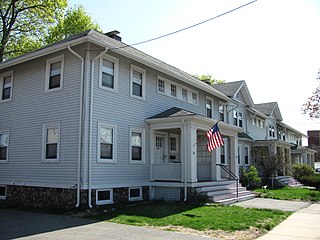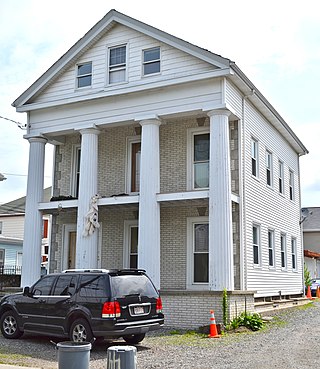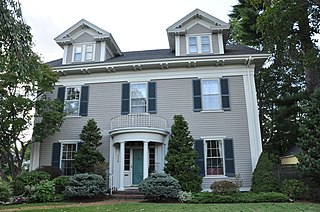
The Metropolitan State Hospital was an American public hospital for the mentally ill, on grounds that extended across parts of Waltham, Lexington, and Belmont, Massachusetts. Founded in 1927, it was at one time the largest and most modern facility of its type in Massachusetts. It was closed in January 1992 as a result of the state's cost-cutting policy of closing its mental hospitals and moving patients into private and community-based settings. The main complex of buildings has subsequently been redeveloped into apartments. The hospital campus was listed on the National Register of Historic Places 1994. The property also housed the Gaebler Children's Center for mentally ill youth.

Christ Church is a historic Episcopal church at 750 Main Street in Waltham, Massachusetts. The church is a parish of the Episcopal Diocese of Massachusetts, and was named to the National Register of Historic Places in 1989.

St. Mary's Roman Catholic Church Complex is a historic multi-building church complex at 133 School Street in Waltham, Massachusetts. Established as a parish in 1835, it is the city's oldest Roman Catholic establishment. Its 1858 Romanesque Revival church and 1872 Second Empire rectory are particularly fine architectural examples of their styles. The complex was listed on the National Register of Historic Places in 1989.

St. Charles Borromeo Church is a former parish of the Catholic Church in Waltham, Massachusetts. It is noted for its historic church building, completed in 1922. A high quality example of Italian Renaissance Revival architecture, it is emblematic of the shift on Waltham's south side from a predominantly Protestant population to one of greater diversity. The building was listed on the National Register of Historic Places in 1989.

The building at 38–48 Richardson Avenue is a historic residential rowhouse in Wakefield, Massachusetts. Built c. 1912, is believed to be one of the oldest rowhouses in the town. They were built by Solon O. Richardson, Jr., on a portion of his family's estate. The building was listed on the National Register of Historic Places in 1989.

The Stark Building is a historic commercial building in Waltham, Massachusetts. The three-story brick building was built in 1891 by John Stark Jr., the owner of a successful manufacturer of watchmaking tools. It is one of Waltham's few surviving and well-preserved Queen Anne commercial buildings, having only received significant alteration to its storefronts. The building was listed on the National Register of Historic Places in 1989.

The Central Square Historic District is a historic district encompassing the central town common of the city of Waltham, Massachusetts, and several commercial buildings facing the common or in its immediate vicinity. The common is bounded by Carter, Moody, Main, and Elm Streets; the district includes fourteen buildings, which are located on Main, Elm, Lexington, and Church Streets, on the north and east side of the common. The district was listed on the National Register of Historic Places in 1989.

The Nathan Warren House was a historic house at 50 Weston Street in Waltham, Massachusetts. Built c. 1889-90 the 2+1⁄2-story house was one of the city's finest Queen Anne residences, with a turret and porte cochere, as well as a variety of decorated projecting sections. The house was built by Nathan Warren, who wrote a history of Waltham, was active in local and state politics, and who was a member of an exploratory expedition to the Yellowstone area in 1873.

The Sanderson–Clark Farmhouse is a historic farmstead at 47 Lincoln Street in Waltham, Massachusetts. The property includes an 1831 Federal style house, along with farm-related outbuildings, including a barn and stable. The property was used as a working farm until the early 20th century. It is now surrounded by 20th-century infill development, although other Federal-era houses associated with the Sanderson family still stand nearby.

The Nathan Sanderson II House is a historic house at 111 Lincoln Street in Waltham, Massachusetts. The oldest portion of this house, a 1+1⁄2-story timber frame section, is said to date to c. 1698. It was moved to its present location c. 1816 by Nathan Sanderson II, son of Nathan Sanderson I, whose house is next door. It was extensively altered at the time, giving it an unusual five-bay front-gable Greek Revival appearance. A single story porch with fluted Doric columns spans the main facade, and the slightly projecting central entry is flanked by sidelight windows. The house is one of several associated with the Sanderson family, who were early settlers of the area.

The Nathan Sanderson I House is a historic house at 107 Lincoln Street in Waltham, Massachusetts. The 2+1⁄2-story wood-frame house was built c. 1783, probably by Nathan Sanderson, over the foundation of an earlier house built by an uncle. It was built in stages, with only two rooms on each floor at first; sometime before 1834 the roof was raised and a leanto added. The leanto was also raised to a full two stories in the 19th century, giving the house its present Federal profile. The house is one of several associated with the Sandersons, who were early settlers of the area.

The Piety Corner Historic District encompasses one of the oldest settled areas of Waltham, Massachusetts. It is centered on a major road intersection, the junction of Totten Pond Road with Lexington and Bacon Streets, and includes the city's largest single concentration of well-preserved 19th and early 20th-century houses. It extends south from Totten Pond Road along Bacon Street as far as Greenwood Lane, and along Lexington Street to Beaver Street. The district was listed on the National Register of Historic Places in 1990.

The North Lexington Street Historic District is a residential historic district at 508–536 North Lexington Street in Waltham, Massachusetts. It consists of a cluster of four houses and their associated outbuildings, built around the turn of the 20th century, and unusual for its state of cohesion and preservation given the busy nature of Lexington Street. Three houses are Colonial Revival in styling, and 528 Lexington is an 1873 Second Empire house. The house at 508 Lexington was built in 1865 and extensively restyled in 1905; it retains some Italianate styling. Particularly rare in Waltham is the converted barn at 526 Lexington Street. This cluster of buildings was traditionally associated with the Piety Corner area, but is now separated from it by a significant number of more modern buildings.

The Newell D. Johnson House is a historic house at 428 Lexington Street in Waltham, Massachusetts. The 2+1⁄2-story wood-frame house was built in 1894, and is one of the most elaborate Queen Anne houses in the city's Piety Corner neighborhood. It has an octagonal tower at one corner with a pyramidal roof, bands of decorative cut wood shingling, and fluted porch posts. Newell Johnson, a dentist, had thi house built on the site of the Sanderson House, one of the first to be built in the area.

The Gale–Banks House is a historic house at 935 Main Street in Waltham, Massachusetts. This farmhouse was built c. 1798, and is one of the finest Federal style houses in the city. It is also significant for its association with Waltham native son, Governor of Massachusetts, and general of the American Civil War, Nathaniel Prentice Banks, who purchased it in 1855 and made it is home until his death in 1894. The house was listed on the National Register of Historic Places in 1990.

The Eastern Middlesex County Second District Court is a historic courthouse of the Massachusetts District Court at 38 Linden Street in Waltham, Massachusetts. Built in 1938-40, it is one of three Art Deco buildings in the city, and its most fully realized example of the style. The building was listed on the National Register of Historic Places in 1989.

The Francis Buttrick House is a historic house at 44 Harvard Street in Waltham, Massachusetts. Built before 1852, it is one of a small number of temple-front Greek Revival houses in the city. It was listed on the National Register of Historic Places in 1989.

The E. Sybbill Banks House is a historic house at 27 Appleton Street in Waltham, Massachusetts. Built in 1892, it is an excellent local example of vernacular Queen Anne styling. It was built for E. Sybbil Banks, the spinster daughter of Nathaniel Prentice Banks who was also a prominent local civil servant. The house was listed on the National Register of Historic Places in 1989.

The Joseph Andrews House is a historic house at 258 Linden Street in Waltham, Massachusetts. Built in 1851, it is one of the city's oldest examples of Italianate architecture, and was one of the first houses built in Linden Street. It was listed on the National Register of Historic Places in 1989.

The House at 18A and 20 Aborn Street in Wakefield, Massachusetts is a historic house and carriage house with elaborate Queen Anne styling. It was built in the mid-1880s, and is one of the most ornate houses in the neighborhood. The property was listed on the National Register of Historic Places in 1989.























